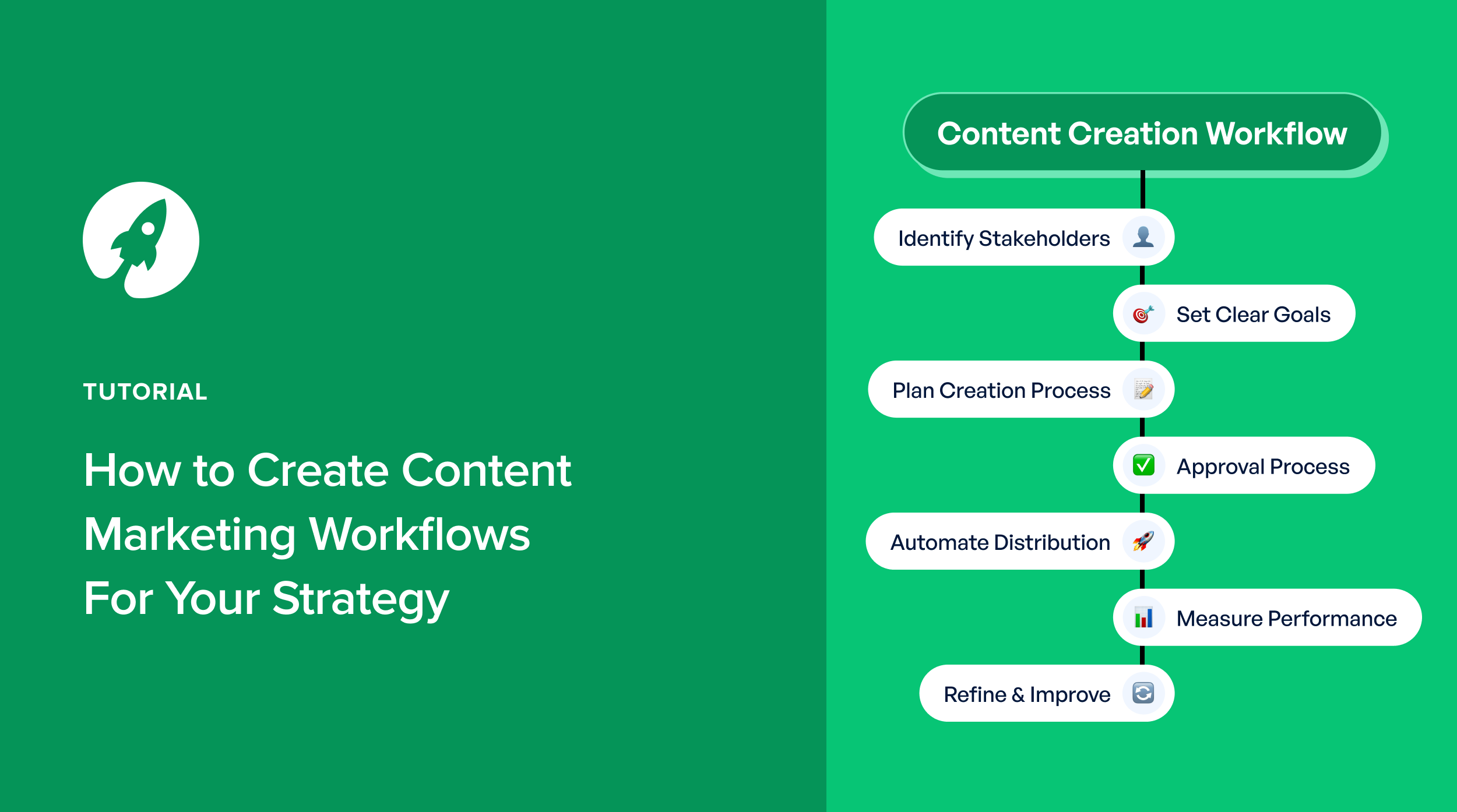If you’re serious about building a repeatable, scalable content strategy, you need structured content marketing workflows.
These aren’t just fancy flowcharts, but the engine that powers everything from ideation to promotion.
So, to help you out, I’ll walk you through exactly how I build, refine, and scale content marketing workflows and how you can do the same without burning out or losing track of your goals.
Let’s start with a definition.
What Are Content Marketing Workflows?
A content marketing workflow is a step-by-step system that outlines how content progresses from idea to publication and beyond. It defines who does what, when, and how.
Think of it as your GPS for content creation. It tells your team exactly where they’re going and which turns to take to get there.
Whether you’re managing a team of writers, collaborating with designers, or working solo with freelancers, a solid workflow ensures:
- No one is confused about their role.
- Content doesn’t get stuck in production purgatory.
- Deadlines are met.
- The output stays aligned with business goals.
And if you’re juggling multiple content types and formats (blogs, case studies, social media, email), content marketing workflows become even more critical.
Without one, it’s easy to waste hours tracking things manually, micromanaging updates, or worse, publishing content that wasn’t ready.
Why Content Marketing Workflows Are Important
Do you know that 63% of B2B marketers report that their organization lacks a documented SEO content strategy, which directly impacts output, quality, and ROI?
Let me be blunt: your content strategy is only as strong as the system behind it.
Without a content workflow, you’ll:
- Miss deadlines.
- Publish low-quality content.
- Burn out your team.
But, with a workflow, you scale output without sacrificing quality and develop a repeatable process that remains effective even as your team expands.
If your content is part of your brand’s voice, it has to sound like you every time. Workflows make that possible.
7 Steps to Create Content Marketing Workflows
Now, let’s look at the 7 steps to create content marketing workflows.
1. Identify Key Stakeholders and Their Roles
When I first led a remote content team across three time zones, one thing became clear fast: unclear roles kill productivity. Someone thought the designer was handling edits. The designer thought the copy wasn’t final. The editor had no idea the piece even existed. Chaos.
That’s why the first step in any content marketing workflow is mapping out your stakeholders and their responsibilities.
Content doesn’t get created in a vacuum. From idea to publication, it touches several hands.
Here’s what a typical team looks like and how to assign roles:
- Content Creators: Your writers, designers, video editors, or anyone producing the actual content.
- Editors: The gatekeepers of quality. They review structure, tone, grammar, and ensure the content matches the tone of voice of the brand.
- SEO Specialists: They make sure your content ranks by integrating keyword strategy, internal links, meta info, and schema markup. Often, this falls under the responsibility of a professional writer.
- Content Managers or Strategists: Oversee timelines, make sure content aligns with business goals, and track performance.
You can also use content management tools like SEOBoost’s Content Management feature or Asana to assign each piece of content an “owner,” reviewer, and due date.
It minimizes miscommunication and eliminates confusion.
You can also create and track your content projects within the same dashboard. This allows you store all your campaigns in one place.
2. Establish Clear Content Goals and Objectives
Once your team is in place, the next step is giving everyone a north star to follow: your goals.
Here’s what I always say: If you’re not clear on what your content is supposed to achieve, why are you even writing it?
Every type of content writing can support many goals, such as brand awareness, lead generation, SEO, nurturing, and retention.
But each piece should serve a specific objective. Setting vague goals like “get more traffic” won’t cut it.
Instead, I’d advise you to use the SMART goals framework.
Here’s a quick breakdown of what that means in terms of setting goals:
- Specific: A good example for this would be, “Increase traffic to the pricing page by 30%.”
- Measurable: Define how success is tracked (e.g., 10K visits, 100 signups).
- Achievable: Don’t expect to outrank HubSpot overnight.
- Relevant: The goal should support a broader marketing or sales objective.
- Time-Bound: Deadlines make things real, so assign them.
When planning blog content, tie every topic to a goal. This clarity not only helps during creation, but it also shapes how you promote and measure success later.
3. Plan Your Content Creation Process
This is the heartbeat of your workflow.
A smooth, repeatable content creation process is the difference between consistently showing up for your audience and playing a monthly game of “why isn’t the blog out yet?”
And trust me, I’ve been in both places.
Whether you’re producing blog posts, videos, or infographics, the content creation process needs to be structured, not rigid, but clear enough that everyone knows what’s happening and when.
Without a plan, content teams waste time reinventing the wheel for every asset.
Worse? Quality suffers when content strategy takes a backseat to speed.
That’s why I follow (and recommend) a 5-step creation process for most content formats:
Content Ideation
Tap into keyword research.
I use SEOBoost’s Topic Reports for this and pair them with LowFruits to understand the audience pain points and competitor gaps.
I also love using tools like AnswerThePublic and Google’s “People Also Ask” to spark topic ideas.
You can also take a peek into my favorite topic research tools.
Research
Before writing, gather data, quotes, and examples to strengthen credibility. For E-E-A-T (Experience, Expertise, Authoritativeness, and Trustworthiness), I rely heavily on primary sources and recent studies (published within the last 12 months, ideally).
Remember, Google favors authenticity, so bring in your own creative writing touch to your content, too.
Outlining
Draft a clear structure with H2s, bullet points, and key messages.
I use SEOBoost’s Content Briefs here as it helps auto-generate outlines and helps me stay aligned with search intent.
Drafting and Refining
Write the first draft with SEO and voice in mind.
This is also where using SEOBoost’s Content Optimization feature helps you check off all the on-page SEO requirements.
Using this feature, you can easily make final tweaks, SEO optimization, and integrate keywords.
Pro Tip: Document this process and create a checklist for your team. New hires will thank you.
4. Implement an Approval Process
Here’s the truth: No content should go live without approval — ever.
Even the best writers miss things. And in my experience, a lack of feedback loops is one of the biggest reasons content fails to hit the mark.
A well-structured process ensures that your message is aligned with your business goals.
It also helps you get the perfect on-page SEO score and keep your tone and grammer polished.
Here’s a simple approval structure I use for blog content:
- First Draft Review: Editors check tone, structure, flow, and factual accuracy.
- SEO and Brand Review: SEO specialist ensures on-page elements are optimized. Marketing or brand leads review messaging consistency.
- Final Approval: Content strategist or marketing manager gives the green light.
This multi-layered review process may sound time-consuming, but it saves hours of cleanup after publishing. More importantly, it builds trust with both your team and your audience.
5. Automate Content Distribution and Promotion
Creating amazing content is only half the battle. If no one sees it, it won’t move the needle.
I used to think great content would “find its audience.” It doesn’t. You have to put it in front of people consistently and strategically. That’s where automation shines.
A strong workflow doesn’t stop at “Approved.” It ends when the content has reached your audience across all relevant channels.
Automating distribution increases consistency without burning out your team. It also ensures multichannel promotion (email, socials, blog, etc.). This, in turn, makes it easier to measure ROI on each piece of content.
Here’s a list of the tools I use and recommend to automate content distribution:
- AIOSEO: Schedule posts with SEO-ready metadata in WordPress.
- Hootsuite: Automate social sharing across LinkedIn, Twitter/X, Instagram
- SEOBoost Content Management: Track publishing status, promotional plans, and performance, all in one dashboard
6. Measure and Analyze Content Performance
Here’s where most workflows break down: they publish, but never look back.
In my early years, I made the same mistake. We were producing content at scale, but we weren’t tracking what worked. And that meant wasting time on topics and formats that didn’t deliver results.
Without data, it can get difficult to justify ROI to stakeholders, identify high-performing evergreen content, and improve future content based on evidence.
Remember, it’s not about vanity metrics. It’s about knowing what drives organic traffic, engagement, leads, and why.
So, here’s a list of some metrics you should watch and why they matter:
- Traffic: Pageviews, source, bounce rate. Helps identify which platforms are working.
- Engagement: Time on page, scroll depth, comments. Signals content quality and relevance.
- Conversions: Leads, downloads, purchases. Tells you if content is actually moving users down the funnel.
- SEO Performance: Keyword rankings, impressions, click-through rate.
Set benchmarks for each stage (traffic, leads, SEO rank) and review content performance quarterly.
7. Continuously Refine and Improve the Workflow
Here’s the truth no one tells you when you start building content workflows: they’re never finished.
Your team changes, your content goals evolve, your tools improve, and your workflow has to adapt.
In my own experience, the most successful brands treat workflows as living documents, not rigid systems.
Refining your workflow helps you stay aligned with shifting content goals and business priorities. They eliminate bottlenecks that slow down content production and help you scale without losing quality.
Here’s how you can do it effectively:
- Conduct Quarterly Workflow Audits: Invite your team to share what’s working and what’s not.
- Track Content Lifecycle Metrics: Look beyond traffic. How long does it take content to go from ideation to publication? Where does it stall?
- Stay Curious About New Tools: AI is changing the game and AI SEO tools like SEOBoost are helping you plan, manage, and scale content faster. Make use of them.
Workflows that evolve with your team’s growth lead to compounding gains: more content, less friction, better results.
FAQs About Content Marketing Workflows
What are content marketing workflows?
Content marketing workflows are structured processes that guide how content is planned, created, approved, published, and analyzed. They help teams stay organized, consistent, and focused on driving results.
What are the best tools to use for content marketing?
Some of the top tools for content marketing include SEOBoost for topic research, briefs, optimization, audits, and content management; Grammarly; Notion; Buffer; and Google Analytics.
What are the best ways to do content marketing?
The most effective content marketing strategies begin with a solid content plan aligned with business goals, utilize data-driven insights to inform topic selection, prioritize quality over quantity, and distribute content across multiple channels.
Final Word
If there’s one thing I’ve learned after years of building content strategies, it’s this: Consistency beats brilliance when backed by a solid workflow.
Workflows aren’t just about productivity. They’re about building the infrastructure for content that drives ROI.
Whether you’re a solo content marketer or part of a growing team, don’t wait for chaos to force structure; build it now.




